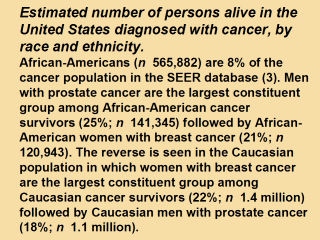| front |1 |2 |3 |4 |5 |6 |7 |8 |9 |10 |11 |12 |13 |14 |15 |16 |17 |18 |19 |20 |21 |22 |23 |24 |25 |26 |27 |28 |29 |30 |31 |review |
 |
Colorectal cancer
is the third most prevalent cancer for both African-American male and female
cancer survivors (12%; n 68,590). Survival data from the SEER
registry (1988–1997), stratified by race and ethnicity and adjusted by age
and stage at diagnosis, show poorer survival for African-Americans than
Caucasians in the database for female breast cancer, male prostate cancer and male and female colorectal cancer (3). Possible explanations for these race and ethnicity survival differentials include differential access to screening, optimal treatment or both; variations in screening rates resulting in lead-time bias (greater survival but no change in total life time) and length bias (screening detects slow-growing tumors with better prognosis); and clustering of socioeconomic status and race and ethnicity data (e.g., a delay in treatment or underuse of screening because of low income) (3). Finally, the importance of diverse cultural factors (beliefs, attitudes and knowledge) in influencing prevention and treatment choices must be considered (15). |